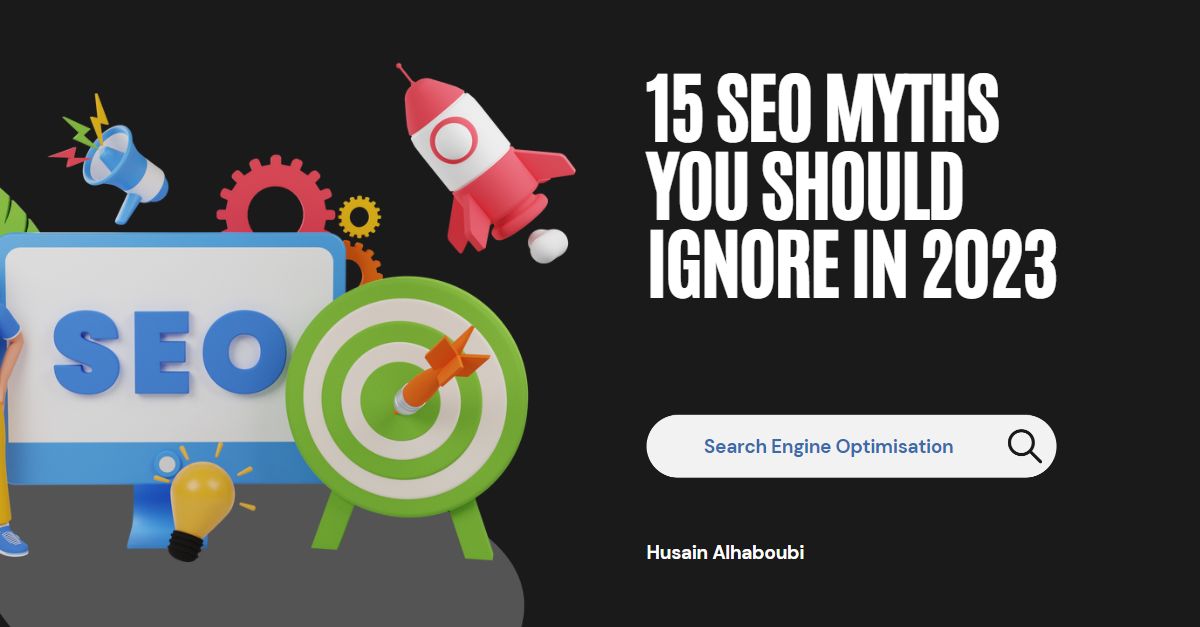
15 SEO Myths You Should Ignore in 2025
Table of Contents
Have you ever found yourself tangled in the web of SEO myths that seem to circulate endlessly in the digital marketing world? If so, you’re not alone. The ever-evolving nature of SEO has given birth to numerous misconceptions that can lead even the most seasoned marketers astray. Today, I am here to set the record straight and debunk 15 SEO myths that you should ignore.
Introduction: Navigating the World of SEO Myths
Search Engine Optimization (SEO) is a crucial aspect of digital marketing that helps businesses increase their online visibility and attract more targeted traffic to their websites. However, the world of SEO is filled with myths and misconceptions that can lead even the most experienced marketers astray. In this comprehensive guide, we’ll dive deep into 15 common SEO myths and uncover the truth behind each one.
Why Understanding SEO Myths is Critical for Success
As the digital landscape continues to evolve, it’s more important than ever to stay informed about the latest SEO best practices and avoid falling prey to SEO myths. By understanding the truth behind these myths, you can focus your efforts on strategies that actually work and avoid wasting time and resources on tactics that don’t deliver results. Whether you’re a small business owner, a marketing professional, or an SEO enthusiast, this guide will provide you with the knowledge and tools you need to succeed in the ever-changing world of search engine optimization.
So, let’s dive in and start separating fact from fiction in the world of SEO myths!
Myth 1: Local SEO is Not Worth It
Many people believe that local SEO is only beneficial for brick-and-mortar businesses that rely on walk-in clients. However, this is one of the common SEO myths. Even if you’re a completely digital business that isn’t location-specific, you can still greatly benefit from focusing on local SEO.
According to a study by Hubspot, 46% of all Google searches are looking for local information. By neglecting local SEO, you could be missing out on a significant portion of your potential audience.
Local SEO uses a variety of techniques, including website content optimization, obtaining local citations, ensuring your business can be located on Google Maps, and creating locally-focused Google Business Profile listings. These strategies can help improve a website’s ranking on Google, making it easier for potential customers to find a business.
Myth 2: New Content is Required to Rank Higher
Content plays an important part in Google rankings, but this doesn’t mean you need to be writing new content constantly to rank better. What you need is fresh content, which is not necessarily the same thing. Instead of constantly creating new content, you can focus on updating and improving your existing content to keep it relevant and fresh.
Google’s “Freshness” algorithm update, released in 2011, does reward recent content for certain search queries. However, as explained by Moz, this mainly applies to trending topics, regularly recurring events, or frequently updated information. For evergreen content, quality and relevance are more important than freshness.
Myth 3: Low-volume Search Terms Are a Waste of Time and Money
There are actually many benefits to targeting long-tail keywords and niche markets, and low-volume search terms often return surprisingly high conversion rates. By focusing on these long-tail SEO myths, businesses can target specific audience segments that are more likely to convert.
In fact, Search Engine Journal reports that long-tail keywords account for 70% of all web searches. While they may have lower individual search volumes, when added together, these lower-competition keywords can drive significant traffic.
Myth 4: Google Will Be Replaced by AI
The advent of AI platforms like ChatGPT might feel new to us, but artificial intelligence has been shaping the search experience for a long time. While AI is becoming more prevalent, it’s unlikely that Google will be replaced entirely. Google has already announced its own AI language model called Bard to address the potential loss of search traffic to ChatGPT.
While AI like ChatGPT may change how we interact with information, it’s more likely to support and enhance search engines rather than completely replace them. For the foreseeable future, SEO will remain an essential part of any digital marketing strategy.
Myth 5: SEO Only Matters For Large Companies
There’s a common myth that only large companies with a massive budget should worry about SEO. However, with the right SEO strategy, even small businesses can make their presence known online and somewhat compete with bigger companies in the digital space.
In fact, SEO can be particularly powerful for small businesses. According to Search Engine Journal, SEO leads have a 14.6% close rate, compared to only 1.7% for outbound leads such as print advertising. By investing in SEO, small businesses can attract more qualified leads and get a better return on their marketing investment.
Myth 6: SEO is a One-Time Thing
SEO is not a “set it and forget it” kind of thing. Much of the hard work is done at the beginning, but SEO is an ongoing process that requires regular updates and adjustments to keep up with changes in search engine algorithms and user behavior.
As highlighted in this article from Forbes, SEO is a continuous process because the digital landscape is always evolving. New competitors emerge, consumer behaviors shift, and search engines update their algorithms. To maintain and improve your search rankings, SEO needs to be a consistent part of your digital marketing strategy.
Myth 7: High Keyword Density is Essential
Keyword stuffing has been dead for many years, but the myth that they’re an important ranking factor seems to persist. In fact, keyword stuffing can actually harm the readability and quality of your content, leading to a loss in rankings.
While it’s important to include your target keyword throughout your content, there’s no magic number for keyword density. As explained by Yoast, a leading SEO tool provider, the focus should be on creating high-quality, relevant content that naturally includes your keywords. Attempting to reach a specific keyword density can lead to unnatural, spammy content that turns off both readers and search engines.
Myth 8: SEO is Dead
This is one of the most persistent SEO myths, but it’s simply not true. SEO is still very much alive and kicking. In fact, organic search drives 53% of all website traffic. SEO is the key to capturing that traffic.
While the tactics may have evolved over the years, the fundamental principles of SEO remain the same: provide high-quality, relevant content that meets the needs of your audience. As Search Engine Journal puts it, “SEO is not dead, it’s simply changing.” Those who adapt to these changes will continue to see the benefits of SEO.
Myth 9: Meta Tags Don’t Matter
While Google announced in 2009 that meta tags don’t factor into their ranking algorithms, that doesn’t mean they’re not important. Meta tags still play a significant role in improving the user experience and click-through rates, which can indirectly affect your rankings.
As explained by Moz, the meta description tag, while not a direct ranking factor, is extremely important in gaining user click-through from search engine result pages (SERPs). These short snippets are your opportunity to advertise content to searchers and let them know exactly whether the given page contains the information they’re looking for.
Myth 10: SEO is All About Rankings
While rankings are important, they’re not the end-all-be-all of SEO. The ultimate goal of SEO is to drive qualified traffic to your website and convert that traffic into leads or sales. Focusing solely on rankings can lead to tactics that don’t necessarily translate into more traffic or better user experience.
In fact, a study by Backlinko found that the top-ranking result on Google only captures an average CTR of 31.7%. This means that over two-thirds of searches don’t result in a click on the top result. By focusing on metrics beyond just rankings, such as click-through rate and conversion rate, you can better assess the true impact of your SEO efforts.
Myth 11: Social Media Doesn’t Affect SEO Myths
While social media signals don’t directly influence search rankings, there’s a strong correlation between social signals and ranking position. Social media can indirectly affect your SEO myths by increasing your online visibility, brand awareness, and attracting backlinks.
A study by Hootsuite found that social media posts are among the most effective ways to build high-quality backlinks. When your content is shared on social media, it’s exposed to a larger audience, increasing the likelihood that other websites will link back to it.
Myth 12: More Pages Mean Better Rankings in SEO Myths
It’s a common misconception among SEO myths that having more pages on your website will automatically lead to better rankings. However, the quality of your content is much more important than the quantity. Focus on creating high-quality content that provides value to your audience.
Myth 13: Paid Search Improves Organic Results in SEO Myths
There’s a myth among SEO myths that spending money on Google Ads will improve your organic search rankings. However, Google has stated multiple times that advertising with them does not improve your organic search rankings. Running Google Ads can have indirect benefits for your SEO strategy, but it won’t directly improve your organic rankings.
Myth 14: Images Don’t Require Optimization in SEO Myths
Many people overlook the importance of optimizing images for SEO. However, images can play a crucial role in your SEO myths strategy. Properly optimized images can help improve your site’s user experience, page load times, and drive traffic through Google’s image search.
Myth 15: SEO is Not a Usability Issue in SEO Myths
There’s a myth among SEO myths that SEO and usability are separate issues. However, the two are closely related. Google’s algorithms are designed to reward sites that provide a good user experience. A site that’s optimized for usability will likely perform better in search rankings.
Bonus: Can duplicate content lead to a Google penalty? No, Google does not penalize sites for duplicate content. However, it can lead to less efficient crawling and dilute your content’s value.
Conclusion
Understanding the truth behind these SEO myths can help you avoid common pitfalls and focus on effective strategies. Remember, SEO is a long-term game that requires patience, persistence, and a commitment to continuous learning and adaptation. So, don’t let these myths hold you back from achieving your SEO goals in 2023 and beyond.
What other SEO myths have you come across? Share your experiences in the comments below!
For more insights into SEO, check out our comprehensive guide to SEO.
